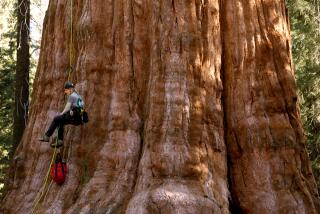Good Views of World’s Oldest Trees
- Share via
High on the stony, storm-battered crests of the White Mountains, east of Bishop near the Nevada border, grow the oldest trees on earth. These 4,000-year-old trees are bristlecone pine, which survive--in fact, thrive--in conditions that doom most other life.
The bristlecones are protected by the 28,000-acre Ancient Bristlecone Pine Forest, set aside in 1958. The forest, which crowns the White Mountains, is under the jurisdiction of the Inyo National Forest.
Bristlecone pines are found in other parts of the Great Basin, in eastern California, Nevada and Utah, but the pines in the White Mountains are by far the oldest.
Bristlecones are old, but they’re not very tall--only 25 feet or so. And they’re slow growers, sometimes expanding only one inch in diameter every 100 years. Some sapling-sized specimens are actually hundreds of years old.
The pines are wonderfully gnarled and contorted--a photographer’s delight. Some assume a sumo wrestler’s stance, others grow nearly parallel with the ground. Their trunks and limbs have been sanded and polished by windblown pebbles and ice.
The name bristlecone comes from the foxtail-like branches with short needles. The cones themselves are purple when young, turning to a chocolate color when mature. Oddly enough, the trees thrive where climatic conditions are most severe, where they are most exposed to the fury of winter storms. Bristlecones clinging to the high peaks live longer than those growing in lower, more sheltered places.
The oldest of the bunch is Methuselah, about 4,700 years old. Many trees in both the Schulman and Patriarch groves are 4,000 years old and still growing.
For many years, bristlecones were thought to be not only the oldest living trees but the oldest living things in the world. More recently, botanists have come to believe that the oldest flora award should go to some of the creosote bushes growing in the Soggy Dry Lake area of the Mojave Desert. Dubbed “King Clone,” the creosote are estimated to be more than 10,000 years old.
Geologists categorize the White Mountains, where the bristlecone grow, as basin- and range-type terrain. The mountains rise quickly and dramatically nearly two miles above the desert floor. Summit views of the surrounding desert are superb.
Two trails explore the Schulman Memorial Grove, named in honor of Dr. Edward Schulman, the scientist who in the 1950s first figured the advanced age of the bristlecones. Bristlecone Discovery Trail is a one-mile, self-guided loop trip suitable for the whole family. Numbered posts correspond to descriptions in a pamphlet available at the trail head. Along the trail is Pine Alpha, the first 4,000-year-old bristlecone discovered by Schulman.
Methuselah Trail is a 4 1/2-mile loop through the Ancient Bristlecone Pine Forest. It features close-up views of the trees and far-reaching panoramas of mountains and desert. As 4 1/2-mile hikes go, this one seems longer, both because of the shortness of breath caused by high altitude and the many photo opportunities en route.
The trail winds through some of the most beautiful parts of Schulman Grove, then climbs to a ridge offering views of the Inyo and Last Chance mountains. An interpretive brochure for the Methuselah Trail is available at the trail head.
Truly heroic hikers will relish the challenge of reaching the summit of White Mountain, the namesake peak of the range. From Schulman Grove, you drive 13 miles up the road to Patriarch Grove, then four more miles to the trail head. A 7 1/2-mile trail leads to the top of 14,246-foot White Mountain, third-highest peak in California, behind Mt. Whitney and its High Sierra neighbor, Mt. Williamson.
The best time to visit the ancient pines is June through October. Summertime is more like springtime in the White Mountains. Patches of snow linger in shady crevices. Wildflowers, such as lupine and Indian paintbrush, do not bloom until August, or even September.
Allow yourself at least half a day to hike both the Discovery and Methuselah trails. At Schulman Grove, where the trails begin, is a small visitors center and some interpretive displays. With the displays and pamphlets, you can learn more about the emerging science of dendrochronology--from Leonardo da Vinci’s discovery of tree-ring dating to modern radiocarbon methodology--than you ever wanted to know. During summer months, naturalists sometimes staff the visitors center and give talks about the bristlecone ecology.
Directions to trail head: This is one hike where getting there really is half the fun--a most scenic drive.
From U.S. 395 in Big Pine, south of Bishop, turn east on California 168 (Westgard Pass Road) and drive 13 miles to the signed turnoff for the Bristlecone Pines. About 5 1/2 miles from the highway you’ll spot Grandview Campground, and a few miles later come to a glorious viewpoint. Sierra View lives up to the promise of its name and delivers a panorama of Eastern High Sierra peaks.
At the end of the paved road is Schulman Grove, where there’s plenty of parking. Both the Discovery and Methuselah trails are well signed.
Methuselah, Bristlecone Discovery Trails Where: White Mountains, Inyo National Forest. Distance: 4 1/2 miles round trip. Level of Difficulty: Moderate. Terrain: Basin and range, rugged mountain crests. Highlights: World’s oldest living trees. Precautions: Hiking in high altitude (9,000-10,000 feet.) For more information: Call the White Mountains Ranger District, Inyo National Forest, at (619) 873-4207.
More to Read
Sign up for The Wild
We’ll help you find the best places to hike, bike and run, as well as the perfect silent spots for meditation and yoga.
You may occasionally receive promotional content from the Los Angeles Times.





